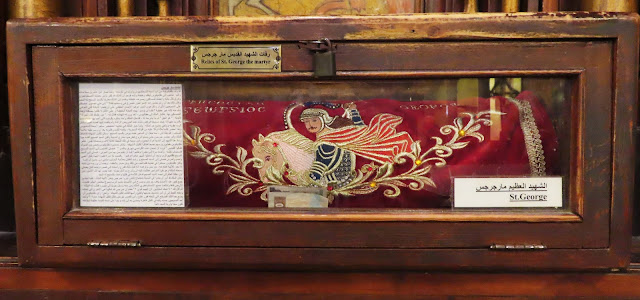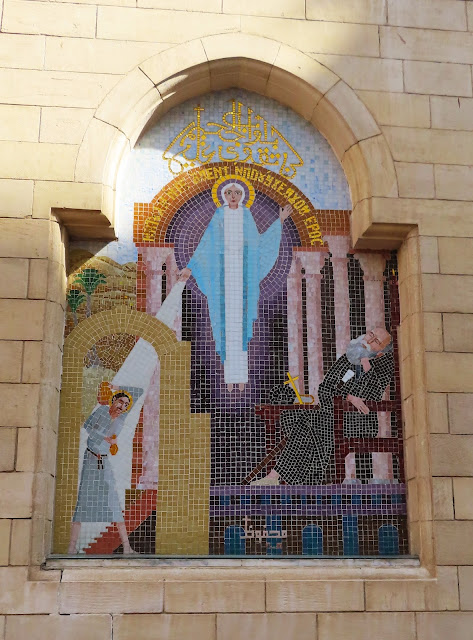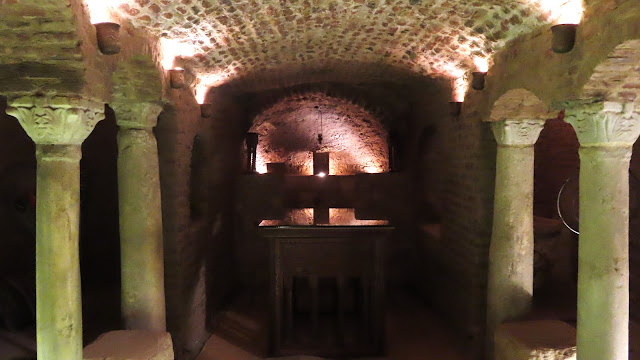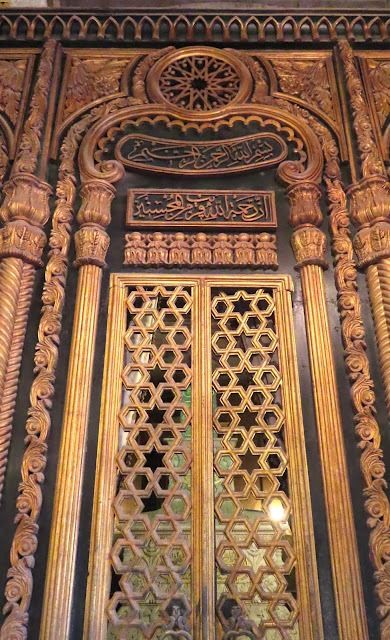February 12, 2023
Cairo: Mosques, Coptic Churches, and an Ancient Market
Rob was feeling the effects of jetlag and two days of tromping around pyramids, so he elected to take a day of rest while I went off with our guide Irene to visit some historic mosques, Coptic churches, and an ancient marketplace.
As always in Cairo, the drive to our destinations was an adventure in itself! I know they must HAVE traffic laws in Egypt, but you would never know it from the crowded streets. If there are three designated lanes, which may or may not have lines to distinguish them, there were usually five cars abreast - and sometimes horse carts, too! There were very few stop lights, so drivers entered the streets, boldly merging with the use of horns rather than turn signals. The honking was constant and hilarious. And amid all this chaos, pedestrians walked right through the traffic, even on the freeways! I asked one of our guides how the pedestrians stayed safe. He responded, "Well, they don't want to get hit, and we don't want the hassle of dealing with the police if we hit them, so we all watch out for each other!"
The Great Mosque of Mohammed Ali Pasha
Our first stop was the Great Mosque of Mohammad Ali Pasha, also known as the Alabaster Mosque, due to the gleaming alabaster facade. The mosque dominates a high hill within the walls of a great fortress erected in the 1100s by Salah al-Din (Saladin) as protection again Crusader invasions.
 |
| Approaching the Mosque of Mohammed Ali |
 |
| The fortress surrounding the mosque |
 |
| The alabaster facade of the mosque. |
Mohammad Ali is considered the founder of modern Egypt. He was Albanian but came to Egypt to help recover it from Napoleon's occupation. He ruled Egypt from 1805 to 1848. He is a well-loved figure here as he reformed the legal system, set up education for women, set up a functional bureaucracy, and instituted other reforms.
The mosque, built in the mid-1800s, reminded me of those we had visited in Turkey. The Egyptians' version of Islam does not appear to be as strict, though, as I did not have to cover my hair or remove my shoes (although little plastic booties were provided to cover the shoes of visitors.) Although the vast interior was not as colorful as the Blue Mosque of Istanbul, it was beautifully decorated with Islamic art. The tomb of Mohammad Ali rests inside.
The ornate clock tower over the courtyard of the mosque has an interesting story. It was given to Egypt by King Louis Philippe of France in exchange for the obelisk that now sits in the Place de la Concorde in Paris. The French got the better end of that deal - the clock has never worked!
From the clifftops, I had sweeping views of the city, although the pollution in crowded Cairo interfered with the sights a bit.
Coptic Churches of Cairo
From the mosque, we moved on to Coptic Cairo, where several historic churches are built within the walls of another fortress dating back to Roman times. It is believed that St. Mark brought Christianity to Egypt around 42 A.D., so the Coptic Christian church of Egypt is one of the earliest sects of Christianity. It split from the Roman and Byzantium branches of the church in the late 300s. (Coptic was the language spoken by Egyptians prior to the arrival of Islam and Arabic.) With the rise of some extremism in the Middle East, there was a lot of security at the gates to the region of churches. However, Irene, who is a Coptic Christian, emphasized that the Muslims and Christians of Cairo now live side by side in harmony.
There are about six churches on the street, and we visited the two oldest and most historic. We first walked up the long staircase to St. Virgin Mary's Church, better known as "The Hanging Church," as it was built in the 3rd century above the gatehouse of an old Roman fort called the Babylon Fortress. Through a glass window in the floor, we could see how the nave was suspended over an open passage.
The Hanging Church is famous for several reported appearances of the Virgin Mary in this location, and there were many images of her around the church, including one called the "Coptic Mona Lisa." The church also contained many relics of saints and martyrs, including St. George (of dragon fame,) as well as many paintings of other saints.
 |
| The Coptic Mona Lisa |
 |
| Iconography of Mary and the Saints |
 |
| Decorative art filled the small church |
 |
 |
| The pulpit |
 |
| St. George seemed to be very popular here. |
 |
| A reliquary holding relics of St. George |
 |
| And another holding relics of St. Abaskhiron, a Coptic martyr |
In the courtyard outside of the church were modern mosaics of St. Mary.
 |
| Mary appears to the people. |
 |
| Another appearance of Mary. |
 |
| The Holy Family flees Herod and takes refuge in Egypt |
We walked a bit further down the street past some of the grander churches.
 |
But our next stop was a small and simple church, Abu Serga, also known as “The Church of the Martyrs Saint Sergius and Bacchus in the Cave,” Sergius and Bacchus having been martyred by the Romans in the 4th century. This church is very sacred as it is built over a cavern which is believed to have been the resting place of Jesus, Mary, and Joseph when they fled to Egypt to escape Herod. I joined the large crowd waiting to enter the little chamber below the floor of the church, and we descended one-by-one into a columned chapel built in front of the little cave. This tiny church was more simply decorated than the Hanging Church, but the earth-colored brick, carved stone, and wood gave a lovely harmony to the sanctuary.
 |
| The Sanctuary |
 |
| The pulpit |
 |
| The crowds waiting to enter the cavern below |
 |
| A temple was built around the cavern where the Holy Family stayed during their sojourn in Egypt. |
 |
| The small cave at the back of the temple. |

Creating a Cartouche
We left the Coptic sector and made a stop at the Mamluk Jewellery and Bazaar where I bought a special souvenir of Egypt - a cartouche, a golden pendant with my name in hieroglyphs. I added Rob's name to the reverse side, so I can always keep him close to my heart. I got to watch the craftsmen make the cartouche, placing the correct symbols on the disc, blasting it with a torch to attach the symbols, and then dipping into water and polishing it clean.
The Markets and Mosques of Khan el-Khalili
Following that stop, we drove to Khan el-Khalili, a busting marketplace that has existed for hundreds of years under the arches of an old caravanserai. It was a crowded and interesting mix of tourist souvenirs and T-shirts side-by-side with the shopping needs of the locals, everything from clothing to food to hardware.
Irene and I enjoyed a huge Mediterranean lunch in one of her favorite restaurants, then we finished the day with a visit to two much older mosques in the same neighborhood, both built by Mamluk Sultans in the late 1200s.
The Complex of Sultan Malik al-Mansur Saif as-Din Qalawun was immense and included the large mosque, a mausoleum, a school, including dormitories for students from the countryside, and a large hospital.
The second, the Madrasa of Al-Nasir Muhammed, was smaller, but had an interesting feature – bent hallways that prevented invaders from shooting directly through to the interior. Both mosques were gorgeously decorated with Islamic art and complex geometric designs.
Finally, it was time to return to Rob and a nice rest in the hotel before packing up for the next day's adventure – a flight to Luxor and a cruise down the Nile.





















































No comments:
Post a Comment